If you’re an avid camper who relies on propane tanks for outdoor cooking and lighting, understanding how to dispose of these tanks safely is essential for environmental stewardship. Improper disposal of propane tanks can pose safety risks and harm the environment. In this guide, we’ll cover everything you need to know about safely and responsibly disposing of camping propane tanks. From why proper disposal matters to step-by-step instructions and safety precautions, let’s ensure that your camping adventures leave no trace behind. Let’s dive in and learn how to protect nature while enjoying the great outdoors with propane equipment.
Table of Contents
Why is it important to Dispose of Propane tanks?
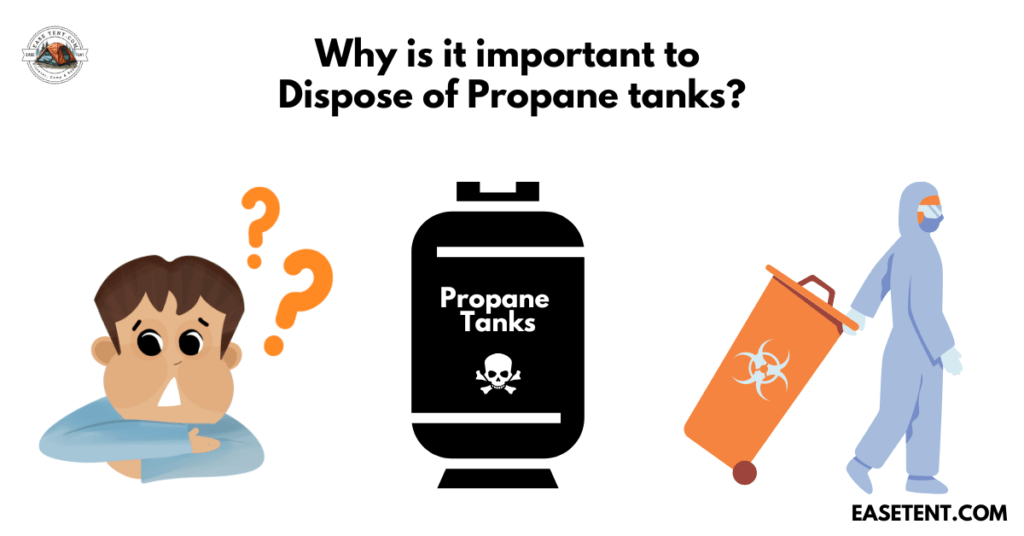
Properly disposing of propane tanks is important for several important reasons.
Reducing the Risk of Fire & Explosion
First and foremost, propane is a highly flammable gas, which means it can easily catch fire or even explode if not handled correctly. By disposing of propane tanks safely, we greatly reduce the risk of accidents like fires or explosions, which could otherwise pose serious dangers to people and property in our communities.
Protecting the Environment
Additionally, disposing of propane tanks responsibly helps protect our environment. When propane tanks are not properly disposed of, they can leak harmful gases that contaminate the air, soil, and water. These gases can contribute to pollution and negatively impact our natural surroundings, harming plants, and animals, and possibly infecting our water sources. By ensuring proper disposal of propane containers, we can minimize these environmental risks and preserve the health of our ecosystems.
Moreover, following regulations for propane tank disposal is essential. There are specific laws and guidelines in place to govern how propane tanks should be handled and disposed of safely. These regulations are designed to protect public safety and prevent environmental damage. By complying with these rules, we contribute to a safer and healthier community for everyone.
Safety Precautions for Disposing the Propane cylinders
When disposing of propane cylinders, it is important to highlight safety to avoid possible issues and ensure proper disposal.
Make Sure the Cylinder is Empty
The initial and crucial step is to ensure that the cylinder is totally empty before proceeding with disposal. Utilize any remaining propane by running the device connected to the cylinder until it no longer creates a flame. This procedure is critical to reducing the possibility of unintentional fire or gas release during handling.
Wear Protective Gears
Additionally, wearing proper protective gear is highly recommended while handling propane pistons. Safety goggles and gloves should be utilized to safeguard yourself from residual propane and to minimize the risk of injury from any sharp edges or protrusions on the cylinder. These safety measures are essential for personal protection and should not be overlooked.
Avoid Physical Damage
Another important safety precaution is to avoid causing physical damage to the cylinder. Handle the cylinder with care and avoid actions that could puncture or damage it. Damaged cylinders can be dangerous due to the potential for gas leaks or other unexpected hazards.
Do Not Attempt to Disassemble
It’s crucial not to attempt to disassemble the propane cylinder yourself. Removing valves or tampering with the cylinder can lead to gas leaks or other safety risks. Leave any modifications or disassembly to trained professionals who can safely handle such tasks.
Store & Transport Safely
When storing and transporting empty cylinders for disposal, ensure they are stored in a well-ventilated, dry area away from heat sources or open flames. During transportation, secure the cylinders upright in a well-ventilated vehicle, such as the open bed of a truck, to minimize risks during transit.
Consult with a Professional
Last of all, always consult local regulations and guidelines for proper disposal methods and designated drop-off locations. Different areas may have specific requirements for handling propane cylinders, so it’s important to comply with local regulations to ensure safe and responsible disposal practices.
Step-by-Step Disposal Process
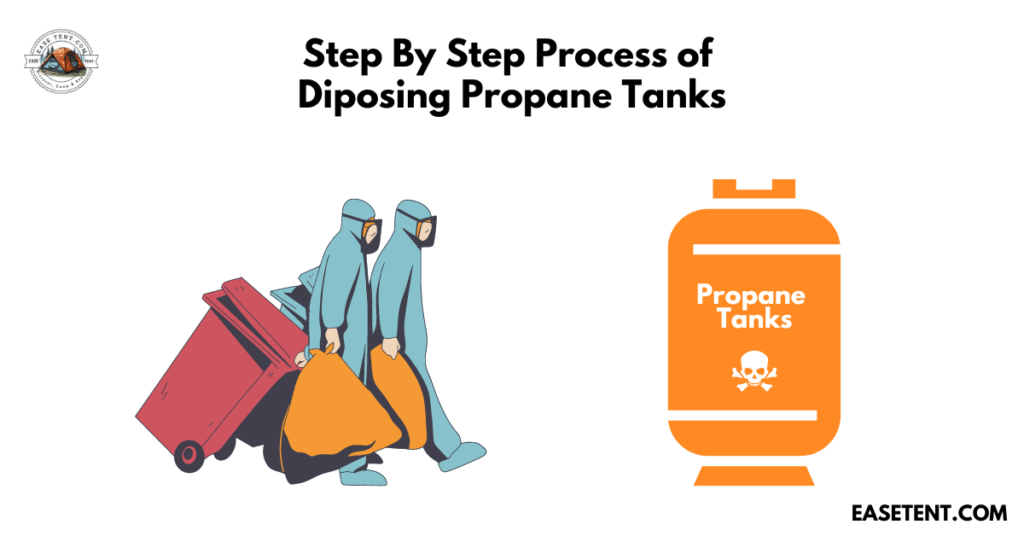
To dispose of a propane cylinder safely and responsibly, it’s essential to follow a step-by-step process that prioritizes protection and compliance with environmental regulations.
Make sure the tank is empty
First of all, confirm that the propane cylinder has been fully depleted of gas before going to disposing the tank. This involves using the connected appliance, such as a grill or heater, until it stops producing flame, ensuring that all propane has been safely expended. Verifying that the propane tank is empty is necessary to avoid any possibility of gas release or safety hazards during handling and disposal.
Detach Valves & Caps
Once the cylinder is confirmed empty, carefully detach any valves or caps attached to the cylinder. This step prepares the cylinder for safe disposal and minimizes potential hazards associated with residual gas.
Research Local Recycling Options
Next, research local recycling options or contact recycling centers, hazardous waste facilities, or municipal authorities to determine the appropriate method of disposal for the propane cylinder. Many areas have specific drop-off locations or programs for hazardous materials like propane tanks. It’s essential to follow local guidelines to ensure proper disposal and environmental protection.
Safe Transportation
When transporting the cylinder for disposal, ensure it is placed upright in a well-ventilated area, such as the open bed of a truck. Avoid exposing the container to direct sunlight, heat sources, or open flames during transit. Secure the cylinder properly to prevent rolling or shifting during transportation.
Drop Off at Designated Location
Upon arriving at the designated drop-off location or recycling center, follow the instructions provided by the facility staff for safe disposal of the propane cylinder. Some facilities may require appointments or have specific hours for accepting hazardous materials like propane tanks. Following these guidelines ensures safe handling and disposal of the cylinder.
Do Not Disassemble or Modify
Lastly, it’s extremely important not to try to take apart, cut, or change the propane cylinder yourself. Doing so can be dangerous and might cause gas to leak out or damage the structure of the cylinder. Instead, let trained professionals who know how to handle hazardous materials safely handle any dismantling or recycling processes. This helps keep everyone safe and ensures proper disposal of the cylinder.
What is a camping propane used for?
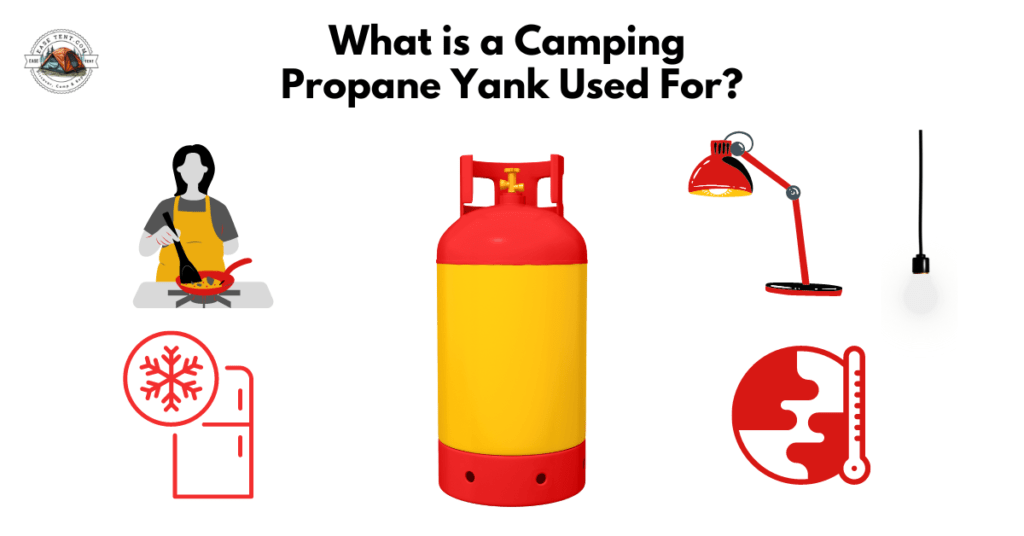
A camping propane tank is a portable container used to store and provide propane gas for various outdoor activities while camping or hiking.
Cooking
One of the common uses of a camping propane tank is for cooking. Propane-powered camping stoves or grills offer a convenient way to prepare meals outdoors, allowing campers to enjoy hot meals even in remote locations. The compact and portable nature of camping propane tanks makes them ideal for use with lightweight and portable cooking equipment commonly used during camping trips.
Heating
In addition to cooking, camping propane tanks can be used for heating purposes. Propane-powered heaters are popular for providing warmth in tents or outdoor spaces during cold-weather camping trips, ensuring comfort and safety for campers in chilly conditions. Propane heaters are available in various sizes and types, ranging from small portable models for individual use to larger units suitable for heating larger areas.
Lighting
Another use of camping propane tanks is for lighting. Some camping lanterns or torches are designed to run on propane, offering reliable illumination in remote or off-grid camping locations where access to electricity may be limited or unavailable. Propane-powered lighting devices provide a practical and efficient alternative to traditional battery-powered or fuel-powered lanterns.
It was September, and my friends and I were out camping in the wilderness. The days had been rainy, which made everything a bit more challenging. Luckily, we had brought along solar-powered lanterns to light up our campsite. But on the second day, the skies were still gray, and our lanterns were running low with no sunlight to recharge them. That’s when my friend had a brilliant idea: why not use propane for lighting? It turned out to be a game-changer for us during those rainy days. Propane became our lifeline, providing steady light and keeping our camping experience going strong despite the weather trying to dampen our spirits.
Personal Story by M Saif
Refrigeration
Furthermore, camping propane tanks can be used for refrigeration purposes. Propane-powered refrigerators or coolers are commonly used in camping setups where keeping food and beverages chilled is essential. These portable propane appliances are especially useful for longer camping trips or when camping in areas without access to electricity, providing a reliable cooling solution.
How long will a camping propane tank last?
The duration a camping propane tank will last depends on its size, the rate of usage of the camping appliance, and environmental conditions. Smaller 16-ounce canisters used for portable stoves typically last 1 to 2 hours of continuous use, while larger tanks used for camping grills can last several hours or even days, depending on usage frequency. Factors like cold temperatures or high altitudes may also affect the efficiency of propane appliances and impact how long a tank lasts. It’s important to consider these factors when planning for propane usage during camping trips.
How many times can you use a propane tank?
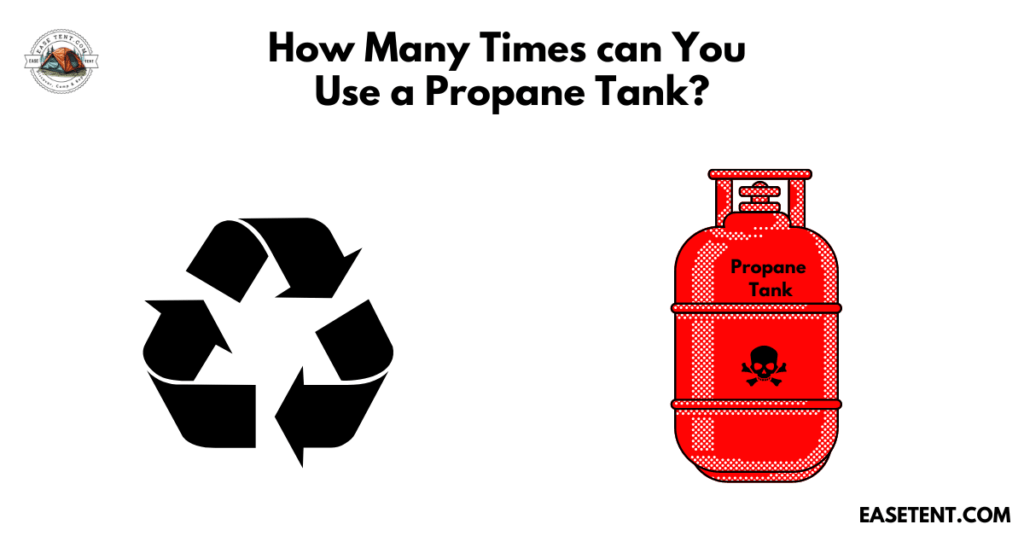
The number of times you can use a propane tank depends on whether it is a disposable or refillable/reusable tank:
Disposable Propane Tanks
The lifespan and reuse of propane tanks vary based on whether they are disposable or refillable. Disposable propane tanks, typically small canisters used for camping stoves or portable grills, are intended for single use only. Once the propane inside is depleted, these tanks cannot be refilled or reused, and they should be properly disposed of according to local regulations. Common sizes for disposable propane tanks include 16-ounce or 1-pound canisters, which are convenient for camping and outdoor cooking but are not designed for multiple uses.
Refillable Propane Tanks
On the other hand, refillable propane tanks, such as those used for larger grills or RVs, can be reused multiple times over an extended period. These tanks are designed to be refilled at propane filling stations or through exchange programs offered by retailers. The lifespan of a refillable propane tank depends on its construction and maintenance. Regular inspections and proper care, including ensuring valves are in good condition and the tank is free of damage, help to ensure the safe and efficient use of the tank over many years.
How much damage can a propane tank do?
Propane tanks have the potential to cause significant damage if mishandled or involved in accidents due to the nature of the gas they contain.
Explosion Hazard
One of the primary risks associated with propane tanks is the potential for explosion. Propane is a highly flammable gas, and if a propane tank is exposed to extreme heat, such as in a fire or due to a malfunction, it can rupture and explode. The force of a propane tank explosion can be powerful enough to cause extensive property damage and pose serious risks to nearby individuals, including severe injury or sometimes death.
Fire Risk
Additionally, improper use or handling of propane tanks can lead to fires. If a propane tank develops a leak or malfunctions and comes into contact with an ignition source, such as a flame or spark, it can ignite and start a fire. Propane fires can spread rapidly and cause damage to structures, vehicles, and surrounding vegetation, posing a significant threat to safety and property.
Environmental Effect
Furthermore, improperly stored or disposed of propane tanks can leak gas, which can contribute to air pollution and pose health risks. Propane is heavier than air and can accumulate in low-lying areas, increasing the risk of fire or explosion if ignited. It is essential to handle, store, and dispose of propane tanks according to safety guidelines and regulations to minimize these risks and ensure the safe use of this versatile fuel source while protecting both people and the environment.
FAQs
Do propane tanks expire?
Propane tanks themselves do not have an expiration date, but they require regular inspection for safety and functionality. The lifespan of a propane tank depends on its condition, including signs of corrosion, rust, or physical damage. Faulty valves or fittings should be checked for leaks. Tanks used for residential or commercial purposes often require periodic testing and certification to ensure compliance with safety standards. Following manufacturer recommendations and adhering to safety guidelines are essential for maintaining the longevity and safe operation of propane tanks.
Conclusion
In conclusion, propane tanks are valuable companions for camping, offering versatility and convenience. However, proper handling and disposal are essential to ensure safety and minimize environmental impact. By following the guidelines and tips discussed in this post, you can confidently use and dispose of camping propane tanks, enhancing your outdoor experience while prioritizing safety and sustainability. Happy camping!
You May Also Like

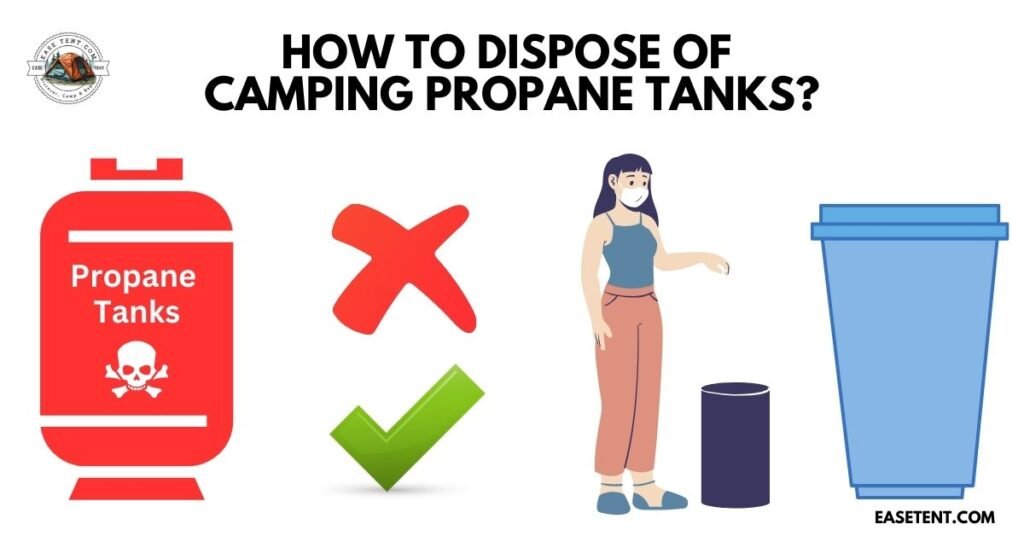
Pingback: Difference Between Butane and Propane Camping Gas?
Pingback: How much Carbon Monoxide does a Camp Stove Produce?
Pingback: Can You Refill Camping Gas Canisters? - The Great Outdoors Blog
Pingback: Difference between Butane and Propane Regulators?